
-
Clean Colorado Sustainability Coalition
2330 McCulloch Blvd. N.
Lake Havasu City, AZ 86403
Phone: (928)453-4152
contact
Threats
Contamination and Invasive Aquatic Species

The Clean Colorado River Alliance, established by Arizona Governor Janet Napolitano, issued a 2006 report covering the most concerned threats to the Colorado River at that time. Recognizing there are many potential threats to the river system, the Alliance decided to focus on what it perceived to be the seven most significant threats, nutrient loading, metals, endocrine disrupting compounds, perchlorate, pathogens/bacteria, salinity/total dissolved solids, and sedimentation. The report also highlights the need for better understanding of the interactions between the river and human activities through monitoring, data sharing, education programs, federal funding for mitigation, and interstate communications. Since the final report was published, the threat of perchlorates has waned due to significant mitigation efforts at the source in Nevada. In addition, steps have been taken to begin the removal of uranium tailings piles adjacent to the Colorado River in Moab, Utah. Expansion of centralized sewer collection systems in Bullhead City and Lake Havasu City have helped to begin the mitigation of elevated nitrates in groundwater that is hydrologically connected with surface water of the river system.
Despite these positive trends, another threat emerged with the 2007 discovery of quagga mussels in the Lower Colorado River (LCR) system. Quagga mussels have the potential to alter the ecological balance in the river/reservoir system and could indirectly exacerbate the threat from pathogens/bacteria and more directly alter the threat of chemical compound contaminants through bio-concentration up the food chain. Indeed, the gaining prominence of toxin producing cyanobacteria and explosive growth of both native and invasive aquatic plants in the reservoirs may be the direct result of quagga mussel feeding habits. Other invasive aquatic species have since been identified in the LCR and there are several groups now focused on these. CCRSCo members are involved in many discussions and actions concerning threats to water quality on the LCR. The discussion below highlights some of the high priority threats.

|

|
| Microcystis outbreak in Lake Havasu 2014 | 2011 Foam on Colorado River south of Parker, AZ |
Nitrates and Septic Systems
The Safe Drinking Water Act has set federal maximum concentration levels in drinking water sources for a variety of elements and compounds. Nitrates, for example, cannot exceed 10 mg/L in a water source without the need for treatment before that water is delivered to customers. Prior to 2000, drinking water and monitoring wells in the Bullhead City and Lake Havasu City areas recorded nitrate concentrations exhibiting highs ranging up to 40 mg/L. The Arizona Department of Environmental Quality believed that the primary source of nitrate came from high density septic tank fields in residential sections of both cities and pressed their case on each city to begin mitigation efforts. The cities, through great expense, decommissioned tens of thousands of septic tanks and work ended in 2011.
In the meantime, the Bureau of Reclamation released a 2005 report that found that the number of septic systems along the river away from Lake Havasu City and Bullhead City, increased over the previous five-year period despite the addition of some centralized collection systems. This reflected part of the population boom period before the Great Recession of 2008.
Increased development density along some LCR stretches mean greater numbers of septic systems are introducing more nitrates to the connected hydrogeology of the Colorado River and the adjacent aquifer. Regional Water Quality Control Board members in California are concerned that in these fast growing areas, developers are proposing septic systems despite the risk of aquifer contamination. Many of the individual developments are small compared to the cities on the river, yet they occur in close proximity of the shoreline and migration paths of wastewater from septic tanks system to the river is very short.
Another interesting aspect of groundwater migration to the river shows up in modeling. The regulated fluctuations in the water elevations of the river and reservoirs, which may change by feet seasonally and by inches diurnally, create a dynamic with the connected groundwater aquifer. When lake levels are high, lake water tends to migrate into the aquifer and serves to dilute the nitrates moving down gradient. When lake levels are low, the highly nitrate charged aquifer moves toward the lake. These conditions will always exist as water supply to customers has the highest priority and maintenance of infrastructure along the river system is perpetual. This is all the more reason to take steps to eliminate the nitrates and the septic systems from which they are being generated.
An important factor makes this even more urgent. Current drought conditions reflected in the levels of Lake Mead and Lake Powell have a significant impact on the contamination of the river aquifer system. With lake levels at 35 to 50 percent of the normal full capacity, levels in the downstream river system will tend to exaggerate the changing water levels. There is little that can be done to change drought conditions, but we can move to reduce nitrates by reducing the septic systems.
Uranium
The Atlas Corporation's 130-acre uranium tailings pile site in Moab, Utah, contained approximately 10.5 million tons of uranium mill wastes, including 426 million gallons of highly contaminated liquid which is seeping from the unlined site.
A 1998 report by the Oak Ridge National Laboratory calculated that even if Atlas capped the site with earth, the uranium-contaminated liquid will leak into the Colorado River for approximately the next 270 years. The EPA states that uranium can cause toxic damage to the kidneys and increases the risk of bone and liver cancer and blood diseases such as leukemia.
The U.S. Department of Energy took over the site in 2001 under the Uranium Mill Tailings Radiation Control Act and in September 2005, approved a plan, now called the Moab Uranium Mill Tailings Remedial Action (UMTRA) Project, in which almost 16 million tons of radioactive waste will be moved from the banks of the Colorado River and buried at a site by Crescent Junction, more than 30 miles to the northwest (and of course, away from the river). By early 2012, 5 million tons were moved and buried and by early 2016 50% of the tailings had been transported. However, due to recent budget cuts, the project may not be completed until 2034. More details about this project are given at www.energy.gov/em/moab-site and UMTRA project updates may be found at www.moabtailings.org.

Uranium tailing piles near Moab, UT
Chromium
Residents along the Colorado River have continuing concerns regarding hexavalent chromium and the potential for surface and groundwater contamination.
The pollution began decades ago when the Pacific Gas & Electric Company (PG&E), which serves central and northern California, used hexavalent chromium to control corrosion and mold in water-cooling towers at an isolated natural gas compressor station south of Needles. From 1951 to 1964, PG&E dumped untreated wastewater into percolation beds in a wash across from its Topock Natural Gas Compressor Station.
A groundwater plume contaminated with chromium was discovered on the California side of the river near PG&E's Topock site and is being cleaned up under the direction of the California Department of Toxic Substance Control. Contaminated water is being trucked more than 200 miles to treatment facilities in California and Arizona, according to DTSC spokesperson Ron Baker.

The plume was estimated to contain at least 108 million gallons with chromium concentrations as high as 12,000 parts per billion (ppb) - California's drinking water standard is 50 ppb - and had reached within 125 feet of the Colorado River. To date, no chromium contamination has been detected in the river, but DTSC has estimated that the plume is moving at about one foot per year.
The Arizona Department of Environmental Quality (ADEQ) is working with California officials to characterize the full extent of contamination and reduce the potential threat to public health and the environment.
The ADEQ has sampled more than 20 potable water supply wells in the area, and collected water level measurements to determine the direction of groundwater flow along the river. Although hexavalent chromium was found in all wells sampled by ADEQ, chromium concentrations detected in the study wells were well below the Arizona drinking water standard of 100 ppb.
PG&E is entering into a remediation design stage to clean up the site, which may take up to 30 years and cost several billion dollars. Final approval of soil investigation work plan, environmental impact report and groundwater basis of design reports will pave the way for the remedial implementation stage. Updates to this effort may be found at www.dtsc-topock.com.
A subsurface chromium plume emanating from the now defunct McCulloch Corporation chain saw manufacturing plant in Lake Havasu City is about one mile from Lake Havasu. Previous exploration work defines two plume levels beneath the water table and about 150 feet below ground level. Groundwater is slowly migrating towards the lake. The Arizona Department of Environmental Quality is moving (in late 2016) to list the site under the Water Quality Assurance Revolving Fund Registry, which was created under the Environmental Quality Act of 1986 to support hazardous substance cleanup efforts in the state.
The U.S. Department of Health and Human Services has determined that some chromium compounds are known to cause cancer in humans. The Agency for Toxic Substances and Disease Registry, meanwhile, states that ingesting large amounts of chromium can cause stomach upsets and ulcers, convulsions, kidney and liver damage, and even death.
Other Contaminants
A number of other contaminants - both organic and inorganic - further contribute to pollution on the Lower Colorado River and threaten the water supply.
Organic contaminants are usually carbon-based chemicals, such as solvents and pesticides, that can get into water through runoff from cropland or discharge from factories. Municipal wastewater discharge from treatment plants and stormwater runoff frequently contain numerous organic contaminants of emerging concern stemming from the use of pesticides, pharmaceuticals and personal care products, petroleum derivatives, cleaning agents and other household products.
The emergence of organic compounds in streams is a relatively recent phenomenon, and there are many uncertainties regarding their effects. Most are not regulated by the EPA. The Arizona Department of Environmental Quality recently released (2016) a white paper compiled by the Arizona Panel on Emerging Contaminants, a group of 35 experts from around the state, that addresses the emerging compounds and pathogens present in Arizona waters (including the Colorado River), provides guidance on managing them in water treatment, and how to communicate this issue with the public.
Below are several categories of contaminates found in the Colorado River.
- Pesticide residues have been detected in the Lower Colorado River at Imperial Dam and the Northern International Boundary. In 1968, the Federal Water Pollution Control Administration concluded that the use of pesticides on irrigated lands was causing contamination problems, a 1973 EPA analysis concluded that pesticide contamination was not a problem on the Lower Colorado River. Nonetheless, fish tissues collected there exceeded California's maximum tissue residue level for several pesticide constituents.
- Pharmaceuticals and personal care products are emerging contaminants found in wastewater streams and have been detected at very low concentrations in Lake Mead and Lake Havasu. Several compounds are known to cause endocrine and physiological disruptions (such as sex changes) in aquatic species and many more compounds are being studied for their potential to cause similar responses in humans. The group under investigation includes both prescription and nonprescription drugs, steroids, insect repellents, fragrances and solvents. Most are not regulated by the EPA. They generally are difficult to remove through conventional treatment methods and, consequently, are highly persistent in the environment.
- Industrial contaminants include compounds such as polychlorinated biphenyls (PCBs) and polyaromatic hydrocarbons which once were used as coolants and lubricants in transformers, capacitors and other electrical equipment. PCBs, which the EPA has identified as carcinogens and priority pollutants, do not readily break down in the environment and may remain there for very long periods of time.
- Inorganic contaminants are compounds that typically do not contain the element carbon in their structure. They can become dissolved in water from natural sources or as the result of human activity. Though they occur naturally, they are regulated in public water supplies due to their ability to cause acute poisoning, cancer and other health effects.
Inorganic contaminants also include a variety of metallic and basic ions that collectively make up the salinity of Colorado River water. They stem from compounds of metals such as sodium, calcium and magnesium and of bases such as carbonates, sulfate and chlorides. Salinity can affect the palatability of drinking water, the durability of appliances and fixtures, agricultural productivity and the amount of water needed for irrigation. This issue is discussed more fully in the Water section on this website.
Quagga Mussels
Since the discovery of quagga mussels in Lower Colorado River reservoirs in early 2007, observations show an explosion in growth and distribution within these reservoirs and connecting canals and reservoir systems that draw water from river. These mussels are growing on any substrate or surface they can find (except copper pipes) and are rapidly clarifying the waters in the reservoirs. As their discovery in the arid southwest is so recent, very little scientific research has been concluded concerning this species, yet managers of water delivery systems and federal, state, and local agencies have scrambled to implement mitigating measures to control and limit the further spread of these mussels. Most North American scientific research on quagga mussels and its close relative, the zebra mussel, has been focused in the Great Lakes region, although published studies from other areas in the eastern United States have shed light on the adaptability of these mussels to new environments. The two mussels belong in the genus, Dreissena, whose name will be used in this summary to encompass research information related to both species.

Feeding quagga mussel
As with many successful exotic species placed in a new environment, Dreissena have had a pronounced ecological effect through its feeding habits. These mussels are extremely efficient, but selective filter feeders of phytoplankton, zooplankton, and other organic and inorganic debris. In doing so, they expel both pseudofeces, unused material mixed with mucus, and feces, processed nutrients and waste products. The pseudofeces provide a desirable nutrient source for protozoan organisms and also contain unwanted cyanobacteria, blue-green algae that can create toxic conditions in the water column if they occur in mass. Filtering algae out of the water essentially clears the water column allowing sunlight to penetrate to deeper levels in the aquatic system. More sunlight, coupled with increased nutrients such as nitrates, leads to more aquatic plant growth on the lake bottom. Green, filamentous algae is the most commonly reported plant group that establish the once barren surface. Some species like Cladophora (which is beginning to grow on the reservoir bottoms as the water clarifies), have contributed to deteriorating environmental conditions by fouling water as it decays and by harboring and promoting E. coli bacterial growth (see photo). Fewer phytoplankton translates to less overall food and to changes in types of dominant plankton species that are generally less nutritious for higher level organisms. These conditions have been known to lead to degraded fish size and populations. Less food has also led to significant population declines of other filter feeding mollusks such as Unionids in the Great Lakes. Quagga mussels have even out-competed their zebra mussel relative in the Great Lakes. Several predators feed on Dreissena, yet the predation rate is far less than the mussel's reproduction rate, leaving mussel populations largely unaffected.
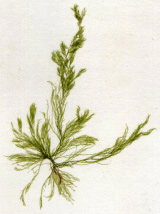
Cladophora
Without a continuous input of these nutrients, phytoplankton production could decrease enough to negatively affect the Dreissena population. Outside sources of nitrogen, in the form of nitrates, and phosphorus, in the form of organic orthophosphates, include septic tanks, effluent disposal, and urban run off. Large amounts from these sources can lead to over production of phytoplankton and other aquatic plants, which can, in turn, enhance mussel proliferation. Algal blooms, such as the blue-green algae, Microcystis, may also develop when these nutrients are released into the water column from protozoans grazing on the mussel pseudofeces. These blooms may lead to oxygen depletion of the aquatic system when the algae die and decay, killing fish and other aquatic organisms. As noted above, toxic conditions may also develop during these blooms. Research suggests that limiting nutrient loading may help control mussel populations.
Most mollusks, including Dreissena, have the capacity to absorb and concentrate contaminants from the aquatic environment. Dreissena also concentrate contaminants in their pseudofeces. In either case, the contaminants may be passed up the food chain to further concentrate the pollutants to levels toxic to higher organisms, including humans. Types of pollutants that have been found in these mussels include chlorinated hydrocarbons, pesticides and herbicides, and heavy metals such as mercury, arsenic, and cadmium.
The relationship between Dreissena feeding habits, nutrient loading and cycling, ecological shifts, and the bioaccumulation of contaminants all result in changes of water quality and a potential threat to the health of the ecosystem, including sport fish and humans. A key to slowing the potential environmental alteration due to the presence of quagga mussels in the Lower Colorado River is to limit the mussel's food source by controlling outside nutrient loading. More information is given in a fact sheet by the Arizona Game and Fish Department (AZGFD)
Cyanobacteria - Microcystis
As introduced in the Water Section, Microcystis looks like algae, but is actually a cyanobacteria (blue-green algae, which is not a plant) that can photosynthesize and has world wide distribution. This is a very primitive, single-cell life form that is planktonic (drifts with the currents – not a swimmer), but it can rise and sink in the water column as it controls its vacuoles. Microcystis has always been in the Colorado River (it is native), but has largely not been prominent as it must complete with stronger competitors (e.g. green algae) for the necessary nutrients in the water. The primary nutrient that is also limited in the Colorado River is a form of soluble phosphorus (called orthophosphate) that can be utilized for cellular growth and reproduction.
With the introduction of the quagga mussel and its tendency to ignore Microcystis and feed rampantly on algae and with warming atmospheric conditions in the region, Microcystis has been able to reproduce rapidly and at times become the dominant phytoplankton in the LCR reservoirs. Microcystis is notable when it first forms numerous colonies that look like yellow-green glitter in the water. When gentle winds create small waves, Microcystis is “herded” in a series of long wind-row accumulations that can become quite obvious (see photo below). The first reported concentrations of this type in Lake Havasu occurred in 2009, only two years after the quagga mussel was discovered. These accumulations usually begin in October and may sporadically occur into the following spring, depending on the winter air temperatures. In fall-winter-spring and early summer of 2014-2015, record warm air temperatures (which translate to warm water conditions) helped to create massive outbreaks up to one mile long of Microcystis in parts of all three LCR reservoirs. These outbreaks make the water look like thick pea soup (see photo below).

|
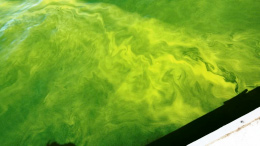
|
| Microcystis Wind-row Accummulations | Microcystis Concentrated Outbreak |
Microcystis is a genus level name and there are many species of this organism. The one species that has been identified in the LCR is Microcystis aeruginosa, which can but produce a toxin (known as a cyanotoxin), depending on local environmental conditions, that can affect liver functions in particular organisms, including dogs and humans. This toxin, known as Microcystin-LR (there are over 90 known variants and this is one of the more toxic ones), is quite stable as a compound over a wide range of temperature and water pH and can persist in the water far longer than the organism itself. It is produced within the organism and can be held there until the organism dies and the cell ruptured. The organism can also expel the toxin while still alive, again depending on local environmental conditions. This is why quagga mussels do not eat the species. Microcystin’s main threat is to swimmers (contact and swallowing water), pets in the water, and surface water supplies used for drinking water. The World Health Organization has set health advisories for water containing more than 1 part per billion of Microcystin and in 2015 the USEPA recommended Microcystin levels at or below 0.3 parts per billion in drinking water for children pre-school age and younger (less than six years old). For school-age children through adults, the recommended Microcystin levels for drinking water are at or below 1.6 parts per billion. This toxin has been detected in all three reservoirs at much higher levels.
Other Aquatic Invasive Species
Not all aquatic invasive species create toxins or tend to clog pipes, but some do have other attributes that make them a threat to the LCR.
The Asian clam, otherwise known as Corbicula fluminea, is well established and widespread in the Lower Colorado River reservoirs and indeed much of the U.S. This species has been known to cause biofouling problems in irrigation canals and pipes and drinking water source infrastructure.
The New Zealand Mudsnail (Potamopyrgus antipodarum) is a relatively new comer to the Lower Colorado River, found to this point only in Lake Mead. The AZGFD has a fact sheet published about the New Zealand Mudsnail.

|
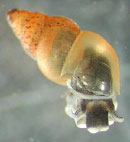
|
| Asian Clam | New Zealand Mudsnail |
Water lettuce (Pistia sp.) and water hyacinth (Eichhornia crassipes) are surface water plants that have recenlyt been reported on the LCR (2016 – see photos). These plants are rapid reproducers that can cover an entire water body over a very short time period. If they get established, it is very difficult to eradicate them.

|

|
| Water Lettuce | Water Hyacinth |
Two longer term invasive plants on the Lower Colorado River include Eurasian watermilfoil (Myriophyllum spicatum) and giant salvinia (Salvinia molesta). As mentioned in the quagga mussel section, the mussels feeding habit can make the water body much less turbid. Eurasian water milfoil and other native aquatic plants have benefited from the increased sunlight penetration and have grown explosively in Lake Havasu. So much so, that the Bureau of Reclamation had to modify its Parker Dam operations, the Central Arizona Project at the Mark Wilmer intake on Lake Havasu had to buy aquatic plant harvester to keep the plants from clogging their intake pipes, and Lake Havasu City also had to buy a harvester to clear waterways for safer boat navigation.
The U.S. Fish and Wildlife Service has been working to eradicate giant salvinia that occurs on the Imperial National Wildlife Refuge reach of the Colorado River north of Yuma, AZ. Like the above two plants, it can quick cover the water surface, blocking out sun light to the water environment. AZGFD has a good fact sheet about this organism.
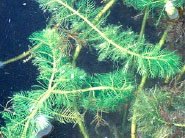
|
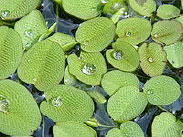
|
| Eurasian watermilfoil | Giant Salvinia |
Yet another type of invasive organism that has been identified on the Lower Colorado River is the microscopic diatom, Didymosphenia geminate, otherwise known as Rock Snot (it is not pretty). Instead of covering the water surface, this diatom tends to coat the bottom of a river, smothering habitat of benthic (bottom dwelling) organisms and inhibiting fish spawning activities. AZGFD also has a fact sheet on this organism at.
There are several informal groups of scientists and water managers that met 1-4 times a year to update river/reservoir conditions, management strategies, and research related to quagga mussels and other aquatic invasive species. These include the Lake Mead Interagency Aquatic Invasive Species Group, The Lower Colorado Aquatic Invasive Species Group, Lake Havasu Quagga Coordination Team, and the Colorado River Aquatic Biologists, which is support by the Lower Colorado River Multispecies Conservation Program.